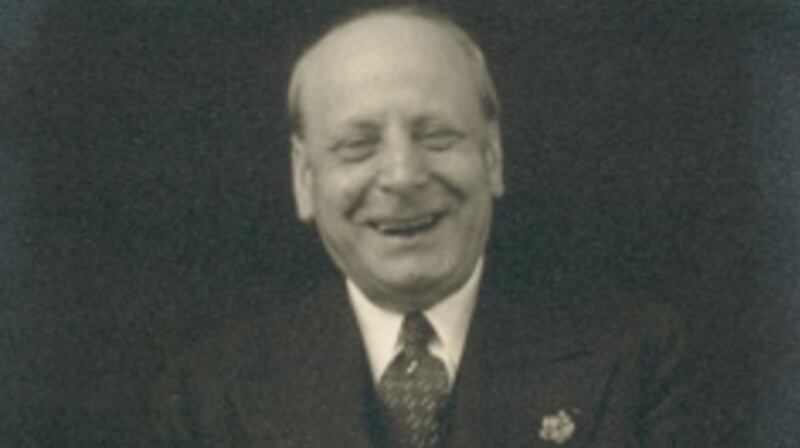With an added ‘e’ in his surname, he might have passed as Irish, even in Dublin. His first name would have been the giveaway, however. And yet as Adolf Mahr (1887 – 1951), he was at least once mistaken for a native son of Ireland. Which may explain why, despite being a member of the Nazi party, he established friendly relations with one of the great Jewish philanthropists of his era.
Mahr was director of the National Museum of Ireland at the time, hired first as a keeper of antiquities under the Cumann na nGaedheal government in 1927, then promoted to the top job by Éamon de Valera in 1934.
Among the donors he worked with in the role was one Albert Maurice Bender (1866 – 1941), the Dublin-born son of a German rabbi. Bender had emigrated to California in his teens and by the 1930s was famous as a patron of the arts in San Francisco. But he had not forgotten his homeland either and from 1932 onwards, in memory of his mother, donated 260 pieces of his Asian art collection to the National Museum.
Mahr, meanwhile, joined a Dublin chapter of the Nazis in April 1933, although it is now generally accepted that he was not inclined to mix his profession as an archaeologist with his politics. This and the fact that, in written correspondence, he always used only the initial of his forename may at first have misled Bender as to who he was dealing with.
Adolf Mahr: Frank McNally on the confused reputation of an Austrian Nazi in 1930s Ireland
Thwarted hotel development keeps doors closed at Dublin pub
Former MEP and Greenpeace activist Grace O’Sullivan’s Antarctic legacy is at risk
‘Stop, that’s my case’ - Áine Ryan on adventures on the Westport non-express
Then in 1933, reflecting on events in Europe, the philanthropist lamented in one of his letters to Dublin that Germany was lapsing into “fourteenth-century barbarism”. In reply, Mahr protested that what was happening there was the result of Germans’ humiliation after 1918, which he warned might yet lead to a second war. So doing, he outed himself as an Austrian, to Bender’s surprise.
[ Adolf Mahr was a most unusual NaziOpens in new window ]

In his 2007 book, Dublin Nazi No. 1: The life of Adolf Mahr, Gerry Mullins writes:
“The hapless Bender, who had dedicated his life to kindness and helping others, was obviously upset. Mahr had always signed his letters ‘A. Mahr’, and although his last name is spelt differently, it is similar to the Irish names ‘Meagher’ and ‘Maher’. So until Bender received this letter ... he could only have assumed that the senior staff member at the National Museum of Ireland, who had such a deep understanding of Ireland and a strong command of the English language, was Irish.”
Embarrassed at what he considered his own faux pas, the Jewish philanthropist wrote back twice in the same day to apologise to the Nazi. Their unlikely friendship somehow survived.
The story is a microcosm of Ireland’s awkward relationship with Mahr. On the one hand, he was an extremely hard-working and dedicated archaeologist, devoted to preserving and promoting the nation’s ancient treasures.
His work with Bender apart, he also was a force behind the famous Harvard University mission to Ireland in the 1930s, which uncovered many interesting facts and artefacts. And he compiled the sumptuous two-volume Christian Art in Ancient Ireland (1932), published to coincide with the Eucharistic Congress (a copy of which, I see, will feature in the latest auction of old books at Purcell’s of Birr later this month).
On the other hand, the main title of Mullins’s book was Mahr’s own description of his political role in the 1930s. It was a role he lived to regret. Returning to Germany and Austria for what was supposed to be a short trip in 1939, he found himself unable to leave again. When he tried to resume his old job in Dublin after the war, he was no longer welcome.
In a letter to this newspaper a few years ago, one of his successors as National Museum director, Pat Wallace, presented a case for the defence: “Adolf Mahr made a terrible mistake by joining the Nazi party. It damaged his life and health ... But he made a major contribution to Ireland and left behind a beautiful family, including his wonderful daughter Hilde ... whom it has been my privilege to know.”
Another letter writer, Fintan Swanton, disagreed: “Mahr was head of the Nazi Party here. One of his contributions to Ireland was launching a Hitler Youth group at his home in Upper Leeson Street ... It was a disgrace to Ireland that a senior public servant was the chief Nazi in our country.”
The Dictionary of National Biography attempts to strike a balance: “Mahr is in many ways a representative of the sort of German nationalist who saw in Nazism a path to national greatness and an opening for meritocrats held down by outworn conventions, without being too particular about the fate of those it regarded as enemies. No assessment of his commitment to Irish culture can ignore either his contributions to the study of the national past or the implications of his activities as what he himself called ‘Dublin Nazi No. 1’.”

















